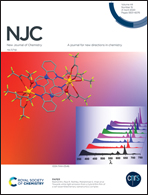Microwave induced transformation of metal organic frameworks into defect rich carbon nanofibers†
Abstract
Amongst the various carbon nanostructures, metal organic framework (MOF) derived carbon (MDC) is rapidly evolving as an attractive material for a wide range of applications such as electrodes in energy storage, catalysts, sensors, gas storage, gas separation, etc. Generally, the transformation of MOFs into MDCs by calcination/carbonization/pyrolysis is a time consuming process with very long reaction times (typically running into hours), high temperatures and in specialized nitrogen or argon atmospheres. Therefore, there is a need for a fast and facile synthesis of MDCs from MOF precursors. In this manuscript, we report a rapid transformation of DABCO (1,4-diazabicyclo[2.2.2]octane) based MOFs into defect rich, nitrogen doped carbon nanofibers by simple microwave radiation in an air atmosphere within 60 seconds. With graphene oxide and carbon fibers as microwave susceptible surfaces, three dimensional nitrogen doped carbon fibers anchored onto reduced graphene oxide (MDNCNF-Co@rGO) and carbon felt (MDCNF-Co@CF), respectively, were obtained. The utility of MDNCNF-Co@rGO as an anode material in sodium-ion batteries and acetaminophen sensors and MDCNF-Co@CF as an electromagnetic interference (EMI) shielding material is reported.



 Please wait while we load your content...
Please wait while we load your content...